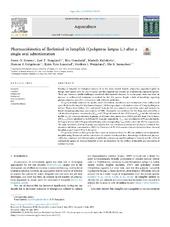Pharmacokinetics of florfenicol in lumpfish (Cyclopterus lumpus L.) after a single oral administration
Kverme, Karen Obrestad; Haugland, Gyri Teien; Hannisdal, Rita; Kallekleiv, Marielle; Colquhoun, Duncan John; Lunestad, Bjørn Tore; Wergeland, Heidrun Inger; Samuelsen, Ole Bent
Peer reviewed, Journal article
Published version

Åpne
Permanent lenke
http://hdl.handle.net/1956/20983Utgivelsesdato
2019Metadata
Vis full innførselSamlinger
Originalversjon
https://doi.org/10.1016/j.aquaculture.2019.734279Sammendrag
Farming of lumpfish for biological removal of sea lice from farmed Atlantic salmon has expanded rapidly in Europe and Canada over the last 5–6 years and the lumpfish has become an economically important species. There are, however, health challenges associated with bacterial diseases. In recent years, there has been an increase in antibacterial treatments prescribed for this fish species despite a lack of knowledge regarding pharmacokinetics and effect of treatment with different antibiotics. The present study examined the uptake, tissue distribution, metabolism and elimination of the antibacterial agent florfenicol in lumpfish (Cyclopterus lumpus L.) following a single oral administration of 10 mg/kg fish given in feed. Plasma, head kidney, liver and muscle from six fish were sampled at each time point and analysed by liquid chromatography/mass spectrometry (LC-MS). Absorption was moderate for this drug characterised by a calculated peak plasma concentration (Cmax) of 3.55 μg/ml obtained after 21.2 hours (Tmax) and the elimination halflife (t1/2β) relatively extended in plasma at 30 hours. Area under curve (AUC) and AUC from 0 to 24 hours (AUC0-24h) were calculated to be 248 and 61 h μg/ml, respectively. Cmax was calculated to 2.99 μg/g in muscle, 2.54 μg/g in liver and 4.70 μg/g in head kidney with corresponding Tmax of 22.1, 26.4 and 19.4 h, respectively. The main metabolite, florfenicol-amine was found in low concentrations in plasma and all tissues examined. The minimum inhibition concentrations (MIC) for florfenicol of 28 of Aeromonas salmonicida isolates from diseased lumpfish ranged from 0.39 to 1.56 μg/ml. The pharmacokinetical data presented here make an important basis for efficient antibacterial treatment for lumpfish using florfenicol and for calculation of suitable withdrawal time. Knowledge of florfenicol pharmacokinetics, combined with determination of antibiotic resistance among fish pathogenic bacteria and the effect of antibacterial agents on diseased lumpfish in vivo are important for the welfare of lumpfish and prevention of resistant bacteria.
